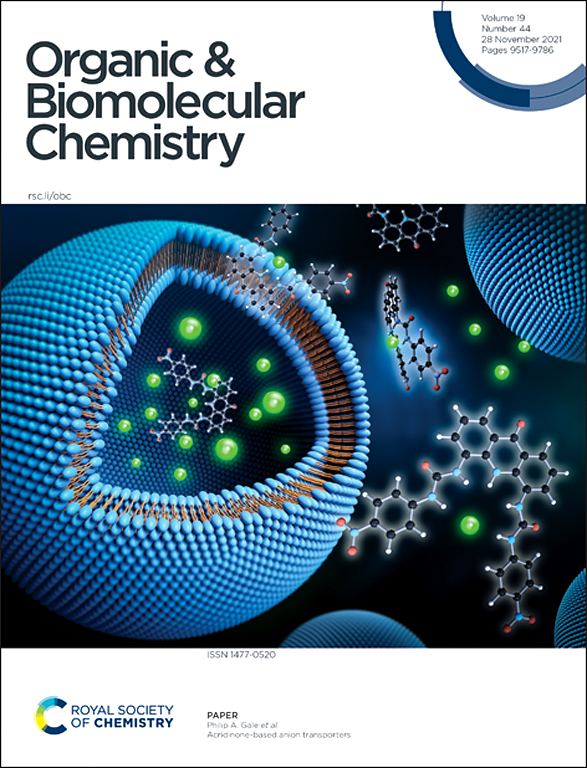铜/铁控制1,3-二烯与乙腈和叠氮三甲基硅烷的区域选择性1,2-碳氮化反应。
IF 2.7
3区 化学
Q1 CHEMISTRY, ORGANIC
引用次数: 0
摘要
以 TMSN3 为叠氮源,MeCN 为氰基烷基化试剂,对 1,3 二烯化合物进行了羧基叠氮化和重氮化反应。该方法对官能团的耐受性极佳,底物范围广,反应时间短,为合成有价值的叠氮化物提供了有效途径。我们的报告介绍了一种前所未有的 1,3 二烯羧氮化和重氮化策略,机理研究表明该反应涉及自由基途径。本文章由计算机程序翻译,如有差异,请以英文原文为准。

Copper/iron controlled regioselective 1,2-carboazidation of 1,3-dienes with acetonitrile and azidotrimethylsilane†
Carboazidation and diazidation were carried out on 1,3-diene compounds using TMSN3 as the azide source and MeCN as the cyanoalkylation reagent. This method exhibits excellent functional group tolerance, a broad substrate range, and a short reaction time, providing an effective pathway for synthesizing valuable azides. Our report introduces an unprecedented strategy for the carboazidation and diazidation of 1,3-dienes, with mechanism studies indicating that the reaction involves a radical pathway.
求助全文
通过发布文献求助,成功后即可免费获取论文全文。
去求助
来源期刊

Organic & Biomolecular Chemistry
化学-有机化学
CiteScore
5.50
自引率
9.40%
发文量
1056
审稿时长
1.3 months
期刊介绍:
Organic & Biomolecular Chemistry is an international journal using integrated research in chemistry-organic chemistry. Founded in 2003 by the Royal Society of Chemistry, the journal is published in Semimonthly issues and has been indexed by SCIE, a leading international database. The journal focuses on the key research and cutting-edge progress in the field of chemistry-organic chemistry, publishes and reports the research results in this field in a timely manner, and is committed to becoming a window and platform for rapid academic exchanges among peers in this field. The journal's impact factor in 2023 is 2.9, and its CiteScore is 5.5.
 求助内容:
求助内容: 应助结果提醒方式:
应助结果提醒方式:


